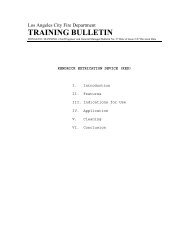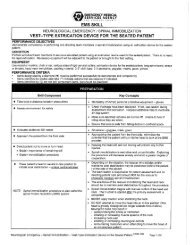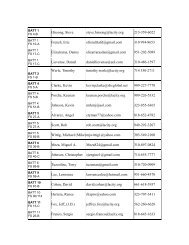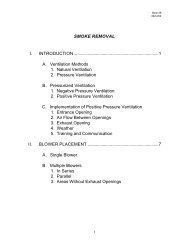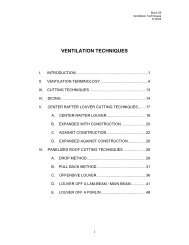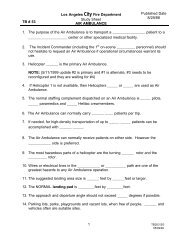Los Angeles City Fire Department - A portal for all your training
Los Angeles City Fire Department - A portal for all your training
Los Angeles City Fire Department - A portal for all your training
Create successful ePaper yourself
Turn your PDF publications into a flip-book with our unique Google optimized e-Paper software.
<strong>Los</strong> <strong>Angeles</strong> <strong>City</strong> <strong>Fire</strong> <strong>Department</strong><br />
Training Bulletin # 67<br />
Date of Issue 3-94 Revision Date<br />
HURST RESCUE TOOL<br />
TABLE OF CONTENTS<br />
I. HURST RESCUE TOOL<br />
II. VEHICLE CONSTRUCTION<br />
III. OPERATING PROCEDURES<br />
IV. MAINTENANCE<br />
V. HEAVY RESCUE<br />
VI. SAFETY CONSIDERATIONS
Training Bulletin No. 67<br />
March, 1994<br />
Page 1<br />
INTRODUCTION<br />
The Hurst Rescue Tool is a hydraulic<strong>all</strong>y powered device used<br />
specific<strong>all</strong>y <strong>for</strong> vehicle extrications and gener<strong>all</strong>y <strong>for</strong> other heavy<br />
rescue applications. It is capable of developing thousands of pounds<br />
of pressure to pull, cut, spread or lift to effect a rescue operation.<br />
Presently, the <strong>Los</strong> <strong>Angeles</strong> <strong>City</strong> <strong>Fire</strong> <strong>Department</strong> employs one brand of<br />
rescue tool manufactured by the Hurst Company:<br />
I. HURST RESCUE TOOL<br />
The Hurst Rescue Tool is comprised of:<br />
A. Power Unit - Two models with different specifications are<br />
depicted on Page 2 (Photos 1 and 2).<br />
The Power Unit is comprised of an engine, hydraulic pump, and<br />
cage.<br />
The engine is a Briggs and Stratton, 4 or 5 horsepower, 4cycle,<br />
air-cooled, industrial gasoline engine. The hydraulic<br />
pump is a positive displacement type pump made by "Hale." It<br />
is rated at 10,000 psi. It will deliver an operating pressure<br />
of 5,000 psi through an internal relief valve.<br />
The pump draws hydraulic fluid from a reservoir with a<br />
capacity of four or seven quarts. The reservoir is located<br />
directly under the engine. The fluid is pumped through a<br />
"dump valve", through the hoses, to the jaws, spreader,<br />
cutting or ram set units.<br />
NOTE: Members using the Hurst Rescue Tool should be aware<br />
of the respective hydraulic oil reservoir capacity.<br />
During operations where many attachments are used in<br />
series, it may be necessary to add fluid to the four<br />
quart capacity model. Conversely, it is necessary to<br />
consider recovery of the fluid that will overflow the<br />
hydraulic oil tank when these attachments are<br />
retracted.<br />
The cage is designed to carry and protect the Power Unit,<br />
hydraulic pump, and reservoir. It is made of stainless steel<br />
tubing approximately 3/4 inches in diameter. The average<br />
total weight of the power unit is 65 pounds.
Training Bulletin No. 67<br />
March, 1994<br />
Page 2<br />
PHOTO 1<br />
POWER UNIT: 4-CYCLE, 4 HP<br />
PHOTO 2<br />
LARGER POWER UNIT: 4-CYCLE, 5 HP
Training Bulletin No. 67<br />
March, 1994<br />
Page 3<br />
In Photo 3 the arrow denotes the primer. In the larger model power<br />
unit the primer button needs to be pushed three to four times be<strong>for</strong>e<br />
starting.<br />
PHOTO 3<br />
B. The Spreaders (Jaws) [Photo 4)<br />
The Spreader Unit is operated by one member with a thumb control<br />
valve c<strong>all</strong>ed a "dead man" switch. Currently, there is one model<br />
made by "Hurst" assigned to <strong>Fire</strong> Companies. The model number is<br />
JL-32B.<br />
• Model JL-32B is a newer model. It has an opening <strong>for</strong>ce of 18,000<br />
pounds at the tips, and a closing <strong>for</strong>ce of 18,800 pounds at the<br />
tips. The opening and closing time (without a load) is 11<br />
seconds. Maximum opening distance between the tips is 32 inches.<br />
Total weight of this unit is 70 pounds.<br />
Both spreader unit models consist of a body and arms made of<br />
aluminum <strong>all</strong>oy <strong>for</strong>ging.
Training Bulletin No. 67<br />
March, 1994<br />
Page 4<br />
PHOTO 4<br />
HURST SPREADER<br />
There are two shackles provided <strong>for</strong> the spreader tips. They are<br />
equipped with a "grab hook" C-8 rated to 13,000 pounds minimum<br />
working strength. Shackles sh<strong>all</strong> be attached to the Jaws by the use<br />
of "Fas-Pins" and sh<strong>all</strong> be applied without removing the tips.<br />
The shackles are used to secure the chains to the tool when<br />
per<strong>for</strong>ming an operation such as pulling the steering wheel away<br />
from the driver's space.<br />
There is a tool box provided <strong>for</strong> storing and carrying these<br />
accessories.
Training Bulletin No. 67<br />
March, 1994<br />
Page 5<br />
C. Hurst Cutting Unit (Photo 5)<br />
The Cutting Unit Model JL-150 has a cutting <strong>for</strong>ce of 25 000 pounds at<br />
the blade's center. At the base of the cutter blades is a "Cable<br />
Cutter" with a cutting <strong>for</strong>ce of 70,000 pounds. The cutter has a maximum<br />
opening travel of 7.25 inches.<br />
The cutting unit body assembly is made of an aluminum <strong>all</strong>oy <strong>for</strong>ging.<br />
Total weight of this unit is approximately 36 pounds.<br />
PHOTO 5<br />
HURST CUTTING UNIT
Training Bulletin No. 67<br />
March, 1994<br />
Page 6<br />
D. Hurst Ram Set (Photo 6)<br />
The Hurst Rams are utilized as an addition to the Spreader and<br />
Cutter. They can be used <strong>for</strong> pushing, pulling, stabilizing,<br />
supporting, and shoring. Three different lengths can be utilized.<br />
They are the 15-inch (JL-20B), 23-inch (JL-30B), and the 35-inch<br />
(JL-60B).<br />
Ram cylinders are made of aluminum <strong>all</strong>oy with the piston rod<br />
constructed of chrome plated hardened steel. This provides high<br />
tensile strength and eliminates side load distortion. The "dead man"<br />
control valve is used to move the piston in and out. It has a dual<br />
check valve to improve load holding capability.<br />
Model JL-20B in the closed position is 15-inches in length, when<br />
fully extended will reach 22-inches. It has a pushing <strong>for</strong>ce of<br />
15,000 pounds and weighs 21 pounds with fluid and connectors.<br />
NOTE: The JL-20B will only extend (push) and DOES NOT have the<br />
capability to provide pulling <strong>for</strong>ce when retracting.<br />
Model JL-30B and JL-60B will provide a pushing <strong>for</strong>ce of 15,000<br />
pounds and a pulling <strong>for</strong>ce of 6,000 pounds. The JL-30B closed is 23inches<br />
with an extension length of 36 inches. JL-60B closed is 35inches<br />
with an extension length of 60-inches.<br />
PHOTO 6<br />
HURST RAM SETS
Training Bulletin No. 67<br />
March, 1994<br />
Page 7<br />
Included with the Ram Sets are Ram accessories carried in a case <strong>for</strong><br />
storage (Photo 7). These attachments are made of investment cast <strong>all</strong>oy<br />
steel and attach to the Rams by the use of "Fas-Pins." This package<br />
contains the following:<br />
l. Conical Point: Makes a quick access hole to prepare an<br />
opening <strong>for</strong> spreading tools.<br />
2. Base Plate: Permits larger bearing surface to better distribute<br />
<strong>for</strong>ces and minimize surface penetration and indentation.<br />
3. "V" Block: Secures gripping of uneven or round surfaces, such as<br />
steering column shafts and pipes.<br />
4. Wedge: Used <strong>for</strong> lifting, separating, cutting, dividing.<br />
5. Jaws Adapter: Allows connection of any attachment to 32-B spreaders.<br />
6. Fas-Pins: For quick attachment hookup.<br />
PHOTO 7<br />
RAM SET ACCESSORIES
Training Bulletin No. 67<br />
March, 1994<br />
Page 8<br />
E. Hoses and Couplings<br />
The Hurst Rescue Tool is provided with three sections of high pressure<br />
hose. Each section is 16 feet in length and is rated at 20,000 psi<br />
burst pressure. The inside diameter of the hose is 1/4 inch.<br />
The hose has a non-per<strong>for</strong>ated polyurethane cover <strong>for</strong> easy maintenance.<br />
The Power Unit, the Jaws, and the cutters have pre-attached sections of<br />
hose 12 to 16 inches in length with spring protectors and quick<br />
disconnect couplings.<br />
The couplings attached to the hoses are of the "slot and pin" design.<br />
F. Hurst Rescue Tool Spreader Accessories<br />
1. The Tips<br />
The Jaws are equipped with a pair of tips that are held in place by<br />
"Fas-Pins." The outside of the tips are serrated to help prevent<br />
slipping. The tips are interchangeable with either arm and are made<br />
of investment cast heat treated steel.<br />
2. Pulling Assembly<br />
Each "Hurst" Tool is provided with three chains; one 12 feet long<br />
and two 6 feet long. All chains have a minimum rated working load of<br />
13,000 pounds (C-8 rated chain).<br />
Chain I - The 12 foot chain is equipped with a “slide hook" on one<br />
end and a "grab hook" on the other.<br />
Chain II - One of the six foot chains is equipped with "grab hooks"<br />
on both ends.<br />
Chain III - The other six foot chain has one "slide hook" on one end<br />
only.
Training Bulletin No. 67<br />
March, 1994<br />
Page 9<br />
II. VEHICLE CONSTRUCTION<br />
A basic knowledge of vehicle construction is necessary when making an<br />
accurate assessment of extrication problems. This knowledge can save<br />
valuable time and keep <strong>your</strong> ef<strong>for</strong>ts from being misdirected.<br />
1. Frame<br />
Vehicles have a structural framework that provides strength,<br />
stability, and passenger protection. In addition, the framework<br />
provides the basis <strong>for</strong> the over<strong>all</strong> shape of the vehicle.<br />
The over<strong>all</strong> effect frame design will have on <strong>your</strong> extrication<br />
operation depends upon the configuration of the vehicle after it<br />
crashes. In most extrication operations the frame will be of great<br />
value when used as a strong point to brace the jaws <strong>for</strong> pushing.<br />
Don't <strong>for</strong>get the underside of the vehicle. The axle and leaf spring<br />
brackets make good anchor points <strong>for</strong> any pulling operation.<br />
2. Shoulder Harness Mounting Brackets<br />
On vehicles equipped with shoulder harness seat belts, there will<br />
be a sturdy metal plate supporting the harness at the roof line.<br />
This plate (three or four inches square) should be avoided when<br />
making cuts with the cutters. The metal on either side of the<br />
mounting brackets will be much easier to cut.<br />
3. Side Impacts Panels<br />
4. Posts<br />
Impact panels are found inside the doors of cars built after 1974.<br />
Using the jaws to pry against these panels in a lengthwise<br />
direction only adds more tension and work <strong>for</strong> the tool. Basic<strong>all</strong>y,<br />
you are trying to pry against the entire side of the vehicle when<br />
moving against these panels. For greater efficiency, work above or<br />
below these panels.<br />
Vehicles get their vertical strength from posts (also referred to<br />
as pillars). Posts are identified alphabetic<strong>all</strong>y starting with the<br />
first post that runs in line with the front windshield. This is<br />
referred to as the A-post. As you proceed toward the rear of the<br />
vehicle, the second post is the B-post, the third post is the Cpost.<br />
This terminology holds true regardless of the position of the<br />
vehicle (upside down, on end, etc.).
Training Bulletin No. 67<br />
March, 1994<br />
Page 10<br />
5. Bumpers<br />
6. Doors<br />
Do not attach chains to recoil type safety bumpers. Attached to<br />
these bumpers are hydraulic or mechanical bumper shocks which help<br />
absorb the impact of light collisions. These bumpers, when weakened<br />
by fire or collision, can suddenly and violently spring three to<br />
four inches. This <strong>for</strong>ward motion has enough power to severely<br />
injure someone standing close to the bumper. In addition, the<br />
bumper can interfere with the proper use of the Jaws in a pulling<br />
operation by springing <strong>for</strong>ward causing the premature tightening of<br />
slack in the chains.<br />
In older vehicles, doors often opened on impact ejecting unbelted<br />
passengers and causing serious injuries. In newer vehicles, doors<br />
are designed NOT to open on impact.<br />
7. Latches<br />
A door latch with a cap on the end of a pin (commonly referred to<br />
as "Nader Bolt") was implemented by the American Auto Industry to<br />
help secure doors during impact. Foreign automobiles use a<br />
different type of mechanism built to a similar standard.<br />
Since 1981, these door latches on new vehicles must be able to<br />
withstand a minimum of 5,000 pounds of <strong>for</strong>ce. Many times, it is<br />
this latch that gives us the most problems when trying to <strong>for</strong>ce a<br />
door open. Try <strong>all</strong> the simple methods first:<br />
• Unlock doors<br />
• Try the outside door latch handle<br />
• Try the inside door latch handle<br />
On most vehicles equipped with power door locks, the driver's door<br />
has the only manual lock. Be aware that battery power is needed to<br />
activate the locking mechanism of the doors. Leave the battery<br />
connected until the doors have been unlocked. Addition<strong>all</strong>y, some<br />
vehicles have to be placed in "park" be<strong>for</strong>e the power locks will<br />
operate.<br />
Familiarizing <strong>your</strong>self with a variety of different makes and models<br />
of automobiles will reduce time wasted at an accident.
Training Bulletin No. 67<br />
March, 1994<br />
Page 11<br />
8. Hinges<br />
Door hinges come apart in two ways when <strong>for</strong>ced open with the<br />
jaws. Older vehicles have cast metal hinges that snap and come<br />
apart quite easily. On newer vehicles the hinges will most often<br />
pull away from the door frame prior to the hinge actu<strong>all</strong>y<br />
breaking. This is a result of the light weight <strong>all</strong>oy metals used<br />
in the body construction.
Training Bulletin No. 67<br />
March, 1994<br />
Page 12<br />
III. OPERATING PROCEDURES<br />
A. Procedures <strong>for</strong> Opening a Door (Photos 8 through 11)<br />
Insert the Jaws into the Spreading the Jaws will<br />
Window; firmly seat the push the top of the door<br />
Lower Jaws tip on the top down and out, away from<br />
of the door. Open the tips the B-post, creating an<br />
so the upper tip is resting opening between the door<br />
against the window frame. and the door frame.<br />
PHOTO 8 PHOTO 9
Training Bulletin No. 67<br />
March, 1994<br />
Page 13<br />
The tip of the Jaws can now be inserted into the opening between the Bpost<br />
and the door.<br />
PHOTO 10<br />
Spreading the tips will eventu<strong>all</strong>y <strong>for</strong>ce the door open at the latch.<br />
NOTE: Photo 11 shows the door latch and “Nader” Bolt exposed.<br />
PHOTO 11
Training Bulletin No. 67<br />
March, 1994<br />
Page 14<br />
B. Procedures <strong>for</strong> Removing a Door (Photos 12 through 14)<br />
Insert tip of Jaws into top of door jam. Spread the Jaws and<br />
break the top hinge first. This will cause the door to rotate<br />
down and away from passengers and operator.<br />
PHOTO 12<br />
An alternate method is demonstrated in this photo. Insert Jaws<br />
tip from the top of the door jam. Spread Jaws and break the top<br />
hinge first.<br />
PHOTO 13
Training Bulletin No. 67<br />
March, 1994<br />
Page 15<br />
Complete the operation by breaking the bottom hinge and removing<br />
the door.<br />
PHOTO 14<br />
Photo 15 illustrates the Ram Set being utilized to push open a door<br />
from the inside. This method is advantageous when access to the other<br />
side is limited, due to the surroundings. Note that the piston end is<br />
positioned near the Nader Bolt area. The base plate should be<br />
attached and positioned on the B-post <strong>for</strong> base support. A two member<br />
team is best when utilizing this particular operation.<br />
PHOTO 15
Training Bulletin No. 67<br />
March, 1994<br />
Page 16<br />
C. Procedures For Removing a Roof (Photos 16 through 21)<br />
Using the cutting unit, cut both A-posts as close to the dash as<br />
possible. This will eliminate a large protruding portion of the<br />
post remaining after the roof is folded back.<br />
PHOTO 16<br />
Cut the roof on both sides, <strong>for</strong>ward of the B-post. (Avoid the shoulder<br />
harness fastening plate.) This will <strong>all</strong>ow the roof to be folded.<br />
PHOTO 17
Training Bulletin No. 67<br />
March, 1994<br />
Page 17<br />
PHOTO 18<br />
Use the pickhead of an axe to punch two holes in the windshield or<br />
push the jaw tips through the windshield. (One at top center and<br />
the other at bottom center.) This will <strong>all</strong>ow the tip of the Jaws to<br />
gain a purchase on the window frame.<br />
PHOTO 19
Training Bulletin No. 67<br />
March, 1994<br />
Page 18<br />
Spreading the Jaws will raise the roof and loosen the windshield.<br />
Remove the Jaws and have one member push the windshield (from<br />
inside car) <strong>for</strong>ward. Remove windshield.<br />
PHOTO 20<br />
Fold roof back and secure with rope.<br />
PHOTO 21
Training Bulletin No. 67<br />
March, 1994<br />
Page 19<br />
D. Procedures For PULLING the Steering Column With the Jaws<br />
(Photos 22 and 23)<br />
Spread the Jaws to its maximum extension. Attach the pulling<br />
assembly to the tips.<br />
NOTE: Fast Pins are inserted from the bottom to prevent them<br />
from accident<strong>all</strong>y being pushed out.<br />
One section of chain should be secured to the underside of the<br />
vehicle. The other section should be wrapped around the steering<br />
column. As the Jaws are closed, the steering column will be lifted<br />
towards the dash.<br />
PHOTO 22
Training Bulletin No. 67<br />
March, 1994<br />
Page 20<br />
PHOTO 23<br />
E. Procedure <strong>for</strong> Pulling the Steering Column With the Ram Set Photo<br />
24 illustrates the steering column lift, similar to the operation<br />
used with the Jaws Spreader. However, the Jaws Spreader is<br />
substituted with the Ram Set in which the same objective is<br />
accomplished.<br />
NOTE: The closing <strong>for</strong>ce of the Ram Set at 6,000 pounds is not<br />
nearly the strength that the Jaws JL-32B at 12,500 and<br />
18,800 pounds can provide during this operation.<br />
PHOTO 24
Training Bulletin No. 67<br />
March, 1994<br />
Page 21<br />
F. Procedure <strong>for</strong> LIFTING the Steering Column With the Jaws<br />
(Photo 25)<br />
The steering column may be pushed away from the driver seat by<br />
placing one tip against the bottom door frame and the other<br />
securely on the steering column. As the Jaws are opened, the<br />
steering column will be lifted toward the dash.<br />
G. Procedure <strong>for</strong> LIFTING the Steering Column With the Ram Set<br />
(Photo 26)<br />
The Ram Set can be utilized to lift the steering column up off<br />
the driver of the vehicle. The utilization of the "V" block<br />
attachment is recommended to enhance the purchase on the steering<br />
column.<br />
NOTE: The use of a piece of plywood or base plate on the floor<br />
board is recommended <strong>for</strong> this operation.<br />
PHOTO 25 PHOTO 26
Training Bulletin No. 67<br />
March, 1994<br />
Page 22<br />
H. Procedures For Moving Seat Awa From The Steering Column<br />
(Photo 27)<br />
The Photo below shows the Hurst Tool cutter being used as a<br />
anchor point <strong>for</strong> the Jaws. First the cutter must securely pinch<br />
the door frame. Then one tip of the Jaws is placed against the<br />
cutter and the other tip is placed against the frame of the seat.<br />
As the Jaws spread the seat will be <strong>for</strong>ced back.<br />
An alternate method would be to use the A-Post as an anchor<br />
point.<br />
PHOTO 27<br />
An alternate method, Photo 28 illustrates the use of the Hurst<br />
Ram Set when it is necessary to push the vehicle seat to<br />
<strong>all</strong>eviate pressure and free the passenger.<br />
PHOTO 28
Training Bulletin No. 67<br />
March, 1994<br />
Page 23<br />
IV. MAINTENANCE<br />
A. Power Unit and Assembly<br />
1. Ignition System<br />
Check spark plug. Gap to proper setting (.030). Replace plug, if<br />
necessary. Spark plugs are available at the Supply and<br />
Maintenance Division. One spare should be carried on apparatus.<br />
Check spark plug wire making sure it makes proper contact with<br />
head of spark plug.<br />
2. Starter<br />
Recoil starter. Pull cord slowly out to its limit, check <strong>for</strong><br />
fraying at <strong>all</strong> points along cord. Check security of attaching<br />
screws or bolts.<br />
3. Air Cleaner<br />
Remove paper or foam air cleaner.<br />
• Paper filter is cleaned by brushing or tapping on a firm surface<br />
to remove dirt and debris.<br />
• Foam filter is washed with soapy water, air dried and resoaked<br />
with 30 weight oil.<br />
Inst<strong>all</strong> air cleaner assembly.<br />
4. Carburetion - Fuel System<br />
• Check carburetor attaching bolts <strong>for</strong> security.<br />
• Visu<strong>all</strong>y check fuel tank. Look <strong>for</strong> dirt in bottom of fuel tank;<br />
if found, remove tank, drain, flush and air dry. Inst<strong>all</strong> and<br />
refill (DO NOT OVERLOOK POSSIBILITY OF DIRT AND RUST IN THE<br />
FUEL CAN).<br />
• Check engine mounts and bolts on carrying frame <strong>for</strong> security.<br />
Check <strong>for</strong> broken mounts, cracks or excessive wear.<br />
• Check throttle assembly <strong>for</strong> proper operation.
Training Bulletin No. 67<br />
March, 1994<br />
Page 24<br />
5. Oil Reservoir<br />
Check crankcase oil weekly and maintain at the proper dipstick level.<br />
If fluid is needed, use 30 weight oil. A complete oil change is<br />
required every 15 to 20 hours of use.<br />
6. Pump and Hydraulic Reservoir<br />
Dump Valve: Check security of the hose fitting screws or bolts holding<br />
the handle to the valve. Check <strong>for</strong> smooth operation. Clean and spray<br />
with silicone.<br />
Reservoir: Fill plug should be hand tight. Over tightening will crack<br />
reservoir top. Maintain fluid level within dipstick marks on models<br />
with dipsticks. On models without dipsticks keep filled 1" to 1-1/2"<br />
from top of reservoir. If fluid is needed, add only MCS 2360 or other<br />
hydraulic fluid approved <strong>for</strong> Hurst Tools.<br />
Avoid getting water on the power unit. Some units do not have seals and<br />
water may enter the tank.<br />
B. Jaw and Cutter Assemblies<br />
1. Main Housing<br />
Inspect housing <strong>for</strong> any cracks. Visu<strong>all</strong>y check <strong>for</strong> any oil residue<br />
or signs of leakage. If any leakage is found, check couplings and<br />
bolts <strong>for</strong> tightness.<br />
2. Trigger Assemblies<br />
Clean, dry and spray the complete trigger assembly with silicone<br />
spray. Operate trigger and <strong>all</strong>ow it to snap back to center. The<br />
trigger must self center. Check <strong>for</strong> fluid leaks. If any are found,<br />
check fittings and <strong>all</strong>en bolts <strong>for</strong> security. Retest the trigger<br />
assembly.<br />
3. Tips (Hurst)<br />
Inspect <strong>all</strong> tips <strong>for</strong> cracks, chips or any distortion. Any broken or<br />
badly chipped tips sh<strong>all</strong> be sent to the Supply and Maintenance<br />
Division <strong>for</strong> exchange.<br />
NOTE: Companies having Hurst tools sh<strong>all</strong> retain one set of tips in<br />
quarters <strong>for</strong> drill purposes. The set of tips that are in the<br />
best condition sh<strong>all</strong> be kept on the tool <strong>for</strong> emergency use.
Training Bulletin No. 67<br />
March, 1994<br />
Page 25<br />
4. Attaching Pins<br />
Visu<strong>all</strong>y check <strong>for</strong> cracks or g<strong>all</strong>ing. Inspect detent b<strong>all</strong> <strong>for</strong> proper<br />
operation. (Push in and see that the spring pressure pushes it back<br />
out.) Use the same procedure on the clevis attaching pins.<br />
5. Arms<br />
Inspect <strong>for</strong> stress cracks or chips. If there is any visible damage,<br />
contact the Supply and Maintenance Division immediately.<br />
With tool operating, spray <strong>all</strong> pivot points and pins with silicone<br />
spray. With the tool fully open, clean and dry the piston shaft and<br />
seal area.<br />
C. High Pressure Hoses and Couplings<br />
1. Hoses<br />
Check weekly and after use <strong>for</strong> cracking, leaks and holes. Clean with<br />
a damp cloth.<br />
2. Couplings<br />
Clean with silicone spray. Check <strong>for</strong> proper operation. Because of<br />
the thermal expansion of warm hydraulic fluid, it is necessary to<br />
disconnect the couplings at the spreader on a daily basis. When the<br />
residual fluid in the spreader warms up it tends to expand causing<br />
enough pressure at the couplings to prevent them from unlocking. If<br />
this occurs you must do the following:<br />
1. Align the female coupling with the check b<strong>all</strong>.<br />
2. Hold the female coupling with a pair of channel locks.<br />
3. Strike the channel locks with a hammer. This should cause the<br />
male and female couplings to disconnect.
Training Bulletin No. 67<br />
March, 1994<br />
Page 26<br />
D. Ram Set<br />
V. HEAVY RESCUE<br />
1. Main Housing<br />
Inspect weekly and after each use. Visu<strong>all</strong>y check <strong>for</strong> any<br />
cracks.<br />
2. Trigger Assemblies<br />
Follow trigger assemblies maintenance B-2, Page 24.<br />
3. Piston Rod<br />
Check weekly and after each use. Clean, dry, and spray piston<br />
rod weekly with silicone spray and operate.<br />
NOTE: After each use turn "dead man" trigger clockwise then<br />
counterclockwise to <strong>all</strong>eviate hydraulic pressure in the<br />
main housing unit.<br />
In recent years the <strong>Fire</strong> Service has been involved in heavy rescue<br />
operations. The result has been the emergence of newer innovative techniques<br />
and equipment. Emergency response to earthquakes, building collapses, trench<br />
rescues, and heavy object removal, have seen the introduction of the Hurst<br />
Ram Set.<br />
The Hurst Ram Set can be utilized not only <strong>for</strong> vehicle extrication, but also<br />
<strong>for</strong> heavy rescue operations. Heavy rescue operations can encompass trench<br />
shoring, moving heavy objects, stabilizing buildings and obstacles, etc.<br />
This chapter will introduce to the members of our <strong>Department</strong>, three uses of<br />
the Hurst Ram Set during heavy rescue operations. The three operations are:<br />
1. Trench Shoring<br />
2. Heavy Object Moving<br />
3. Utilizing the wedge to access a purchase <strong>for</strong> the Jaws Spreader.
Training Bulletin No. 67<br />
March, 1994<br />
Page 27<br />
WEDGE SPREADER<br />
The wedge may be used to move a heavy object in situations that require a<br />
purchase <strong>for</strong> the use of the Jaws or Ram Set.<br />
Photos 29, 30 and 31 show how the hurst ram with the wedge attachment can be<br />
utilized. A wedge block should be used in conjunction with the wedge<br />
attachment to eliminate the possibility of the object lowering.<br />
Once an access point is established, put the tips of the jaws spreader in and<br />
lift (see Photo 31). Replace the wedge with a wedge cribbing and continue to<br />
lift to the desired height. Remember to always crib as you lift.<br />
PHOTO 29
Training Bulletin No. 67<br />
March, 1994<br />
Page 28<br />
PHOTO 30<br />
PHOTO 31
Training Bulletin No. 67<br />
March, 1994<br />
Page 29<br />
PHOTO 32<br />
PHOTO 33
Training Bulletin No. 67<br />
March, 1994<br />
Page 30<br />
TRENCH SHORING<br />
Photo 34 shows the use of the Hurst Ram Set <strong>for</strong> trench shoring. To lower the<br />
Hurst Ram, feed the drop bag line through the eyes of both tips. Proper<br />
positioning requires that the lip of the trench be stabilized first at ground<br />
level. Plywood sheeting is then lowered on both sides of the trench. Use a 2"<br />
X 6" or larger size planks <strong>for</strong> shoring uprights, as shown in the photo. Now<br />
lower the Hurst Ram two feet below ground level and extend Ram Set to apply<br />
pressure to the uprights.<br />
When utilizing the Hurst Ram Set in a shoring operation, it is recommended<br />
that the Heavy Utility, the Disaster Preparedness Section members, or other<br />
members certified in trench rescue, heavy object moving, or rescue systems be<br />
on-scene.<br />
PHOTO 34
Training Bulletin No. 67<br />
March, 1994<br />
Page 31<br />
HEAVY OBJECT<br />
Photos 35 and 36 shows the Hurst Ram being utilized <strong>for</strong> heavy object moving.<br />
Notice the cribbing used in conjunction with the Hurst Ram. The technique of<br />
lift an inch and crib an inch sh<strong>all</strong> be used during this operation.<br />
PHOTO 35<br />
PHOTO 36
Training Bulletin No. 67<br />
March, 1994<br />
Page 32<br />
VI. SAFETY CONSIDERATIONS<br />
DOC. 1090020/33<br />
1. Prior to any patient extrication, ensure that the vehicle or<br />
other involved objects are properly chocked and/or cribbed.<br />
2. Wear gloves and eye protection when connecting and<br />
disconnecting hydraulic line couplings. Hydraulic fluid may be<br />
irritating to the skin and eyes.<br />
3. Double check <strong>all</strong> connections.<br />
4. Maintain a safe incident work area that is clear of<br />
obstructions and free of unnecessary personnel.<br />
5. Maintain a safety member at the power unit "dump valve" at <strong>all</strong><br />
times to be available should the need arise <strong>for</strong> an emergency<br />
shut down. Keep the line of sight clear between the member<br />
using the tool and the person controlling the dump valve.<br />
6. Do not straddle the hydraulic lines while operating tools.<br />
7. Keep <strong>all</strong> parts of the body from between the tool and the object<br />
being worked on.<br />
8. During cutting and spreading operations make provisions to<br />
control parts which break free with great <strong>for</strong>ce (i.e., doors,<br />
seats, and brake pedals).<br />
9. To prevent hydraulic line damage, verify that their location is<br />
clear of the anticipated operations.<br />
10. When replacing the power unit onto the fire apparatus, be aware<br />
of the hot muffler.



